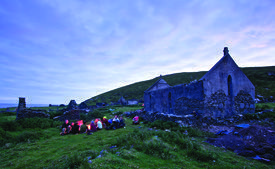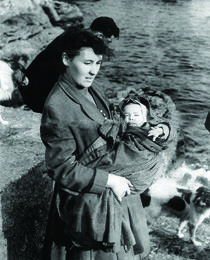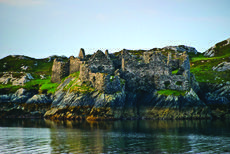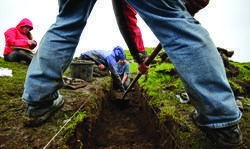This article originally appeared in the Autumn 2012 issue of Notre Dame Magazine. In honor of St. Patrick's Day, we republish it here as part of Magazine Classics, a new series highlighting notable works from the magazine’s archives.

Running the opposite direction of most Irish stories, Theresa Lacey’s tale begins in tragedy and ends in a wistful longing.
Lacey was 25 years old in 1960 when she and the last two dozen residents evacuated her ancestral home of Inishark — Shark Island — a rocky emerald jutting from the sea seven miles off the western coast of Ireland. After thousands of years of struggle and survival in harsh conditions on the fringe of Europe, the modern world came in a rush. And an ancient County Galway island that once harbored more than 300 souls died in a day.
For Lacey, it was an idyllic childhood, isolated from the Irish mainland and the boundaries polite society placed on women of the era. She fondly remembers doing every kind of work: rowing the traditional currach boats, fishing with her father, sowing rows of potatoes, cutting turf peat for the fire, even killing sheep herself.
- Related articles
- Standing in their footprints
- Inishark: Death of an Island video
Now 76 and sitting inches from a roaring stove in a government-built house on the mainland, Lacey insists on more tea for all. I’m sitting on a couch in her kitchen with Ian Kuijt, the Notre Dame anthropology professor whose team of students has been excavating and mapping and studying Inishark life for the past six years. She clearly loves answering questions about the way it was.
An added lilt enters her voice when Lacey describes island celebrations — the music played and stories told at her old school, which transformed into a social center at night. She recalls lighting summer bonfires on the hill to celebrate Saint John’s Night, residents singing and dancing and drinking like bacchanal pagans, then spreading the ashes over the potatoes — an island ritual to make them taste better than mainland spuds — as the sun rose over the Atlantic.
The loss of their home is an emotional tale for the surviving Sharkers, now fewer than a dozen. One man broke down in tears trying to describe it, despite the half-century intervening. Islands along the length of the western Irish coast share similar stories of population loss or abandonment, leaving the survivors worried that a cherished way of life will someday be forgotten.
Kuijt’s undergraduate and graduate students have been collecting these stories, plus archaeological evidence and historic records, as part of a project called Cultural Landscapes of the Irish Coast (CLIC). Their goal is to shed light on a fascinating culture and history in danger of becoming another legend.
“I still love that island,” Lacey says. “I never felt isolated there. I’d go back in the morning and live there and die there, but who would be the idjit who’d go with me?”
Few would. When they left, just nine years before the first moon landing, island life had changed little over the past centuries. There was no electricity, running water or telephone lines. The island has no natural harbor, so the weather often stranded residents for days or weeks when boats could not land. A century of emigration had recently escalated, leaving the island without enough strong young backs for the physical labor needed to survive.
After Shark residents were socked in for a brutal seven-week stretch in 1959 that included an airdrop of supplies, the government finally granted the residents’ request to evacuate. But harbingers of the end of centuries of occupation had come earlier.
Drowned hope
On Easter Sunday in 1949, two Lacey brothers and a cousin — the family Theresa later married into — rowed a currach from Inishark across the channel to Inishbofin, a larger island with a full-time priest, doctor and store.
Returning after Mass, they capsized and drowned; two of the bodies were never found. On an island that size, three youngsters were known to all and represented a large share of the workforce. Fishing and boating disasters were considered a part of island life, but the stress became harder to tolerate after the drownings. Lacey said the women and elderly would watch the lads go out fishing at night, then sit awake terrified at the sound of a change in the wind. The fear was magnified because few fishermen could even swim.
The island’s death knell came in 1958, when a neighbor had become ill with what Shark residents suspected was appendicitis. They couldn’t launch a boat in the high winds and waves, and they couldn’t call the mainland for a helicopter. The government in Dublin would not install a telephone line for fewer than 100 people.
Leo Murray, another Inishark evacuee who now lives near Lacey, recalled the desperate solution: He and others went to the top of the highest hill on the island and lit a large fire that could be seen on Bofin a mile away and even the mainland seven miles away, hoping help would be sent. Nothing else could be done, and the neighbor died three days later.
“That was a real shame, because we could have saved him,” Murray says. “It was preventable.”
After years of refusing to invest in a better harbor and boat landing, the government finally granted the islanders’ last resort: It built simple houses on the mainland and sent a priest to oversee the evacuation. Lacey said the final day was so shocking she can hardly remember it. Here is how a reporter from the Daily Mirror described the scene:

“The last . . . members of six families moving out of Shark like a garrison surrendering after a life time’s siege. . . . Men, women and children were staggering along the stony 500 yards between their cottages and the landing stage with their burdens. . . . A huge, home-made wardrobe lashed to the shoulders of . . . Michael Cloonan. A dark brown cat in an old blackened cooking pot. . . . Anne Murray’s geraniums, hens in baskets, geese in sacks, straw brooms and string-tied suitcases, iron bed-steads and baths. . . . and a tear in the eye of Thomas Lacey.”
Thomas Lacey was Theresa’s father-in-law, who stayed an extra night alone on the island, leaving the door open and setting the table for his lost sons. He left the next day, finally at peace. Theresa had never seen her new home before arriving at night with three kids in tow.
“It was a cold house, and there was nothing but a single chair,” she says. “I sat there with the baby in my lap waiting for the furniture. It was diabolical. The next day, my husband went outside to plant potatoes. The ground was nothing but rock.”
Lacey said today’s young people, including her own 10 kids, aren’t interested in the old ways. While modern convenience has benefits, she also appreciates that the world left behind has found a rapt audience from Notre Dame. The stories and silent ruins are all that is left, but what wonderful tales they tell.
Not just legends
Two menacing green eyes seem to stare through me from the ruins of a 17th century fort as the ferry enters the harbor of Inishbofin. Inishark’s neighboring island, rejuvenated by electricity in the 1980s and the tourism that followed, is the base for exploring the region.

The eyes are really holes in a crumbling wall, and their color comes from the grassy moss on the hill behind, but the impression of a skeleton warning off visitors is hard to shake. If Disney built these ruins at a theme park, you would shake your head over how perfect and phony they look.
The reality is more chilling: Oliver Cromwell built the fort as a penal colony for Irish priests, considered dangerous because those who could read and write might foment rebellion. A boulder at the base of the fort is called Bishop’s Rock because Cromwell reportedly lashed a bishop there and let the tide rise and drown him.
In Ireland, legends and history aren’t just tales taught in school. The remains of the past surround the Irish people and the stories seep into the bones. With so many centuries and so few records, reality and myth tend to intermingle more fluidly than in youthful America or document-rich England.
On the other point of the harbor entrance, little can be seen of the former castle of Grace O’Malley, a redheaded pirate queen who marauded around the western Irish seas in the 16th century. Local storytellers say O’Malley once took revenge on rival clan members who killed her lover by stealing their boats and stranding them to starve on a deserted island. When she famously met with Queen Elizabeth I in 1593, these strong women negotiated — in Latin — an end of piracy in exchange for the release of O’Malley’s sons from an English prison.
In Irish, Inishbofin means “Island of the White Cow.” It takes its name from an old legend: Two fishermen lost in a fog came upon the enchanted island. They stoked a fire from peat they carried in the boat. Suddenly the mist lifted and an old woman appeared, driving a white cow. She struck the cow, and it turned to stone.
I prepared for the trip by watching a terrific family movie called The Secret of Roan Inish. A young girl returns to an abandoned Irish island and believes she has found the lost baby brother who floated out to sea on their evacuation day. She believes he has transformed into a selkie, a mythic creature that is half human and half seal. The parallels to Inishark are uncanny, and I look warily for the seals that often bask on these islands.
Island legends seem more numerous today than the people, who have dwindled on Inishbofin to fewer than 200 from five times that number a century and a half ago. The island is believed to have been inhabited for up to 10,000 years. Celtic forts have been dated to about 1000 B.C., and other evidence points to Bronze Age residents. The first written accounts come from Saint Colman, a Connemara monk who founded a monastery on the island in 668 A.D.
Legend holds that Inishark shares a similar history not fully told. The roofless houses, stone walls and potato ridges speak of the lives of the people who called Inishark home for centuries. Looking across the channel from Bofin, I feel an eerie sense of loss similar to visiting a western ghost town.
Down the coast off the Dingle Peninsula, the archivist of The Great Blasket Centre tells nearly the same story of Great Blasket Island’s 1953 evacuation: emigration, a bad pier, fishing disasters, a medical emergency and too little population.
“It’s unlucky,” says Daithi de Mordha, the archivist, “They missed the tourist boom by 20 years. If they could have held on and gotten a better pier, they might still be there.”
The western isles used to be the bus stops of heavily trafficked shipping lanes before roads made the mainland more accessible. Now, on a wind-whipped rainy day, the islands feel like the furthest edge of civilization holding out precariously against the battering Atlantic Ocean.
Silent, unmarked headstones
Doonmore Hotel on Inishbofin soon puts the cold, lonely feeling to rest. A half mile from the pier on a one-lane road, the complex owned by the Murray family overlooks the harbor. Margaret Murray, the owner whose daughter Aileen runs the operation, once taught school on Inishark for two years.
A pub serving homemade brown bread, creamy Guinness and occasional Irish music is filled with locals and about a dozen American students from Kuijt’s team. Having just spent two weeks camping and excavating on Inishark, they will spend the next week cleaning and analyzing what they have found. In another room, a table for laptops sits next to heaps of tagged pottery shards, unusually shaped bottles and the remains of broken tools and other unearthed trash treasures.
The Murray family and their employees treat the ND group like old friends. I’m quickly introduced to Tommy Burke, a local farmer and oral historian. Over several days, Burke, 41, shared his trove of island stories. He met Kuijt years ago while working on the ferry and was delighted to join this summer’s dig team on Shark, especially since he had just been accepted to study archaeology at a college in Galway.
Kuijt, a Canadian of Irish and Dutch descent, first came to western Ireland on his honeymoon in 1995. Though he was working on a major project in Jordan at the time, he knew he wanted to return to Ireland. So when he came to Notre Dame in 2000 with his anthropologist wife, he began teaching a class on Irish archaeology and history, especially the Potato Famine of the 1840s.
He first visited Inishark in 2006 with Irish archaeologist Michael Gibbons. They had lunch near the graveyard, and Kuijt was taken by the peacefulness of the silent, unmarked headstones and the abandoned homes. He’s the type of intense academic who often uses the word “stunning,” and he felt a need to learn more about the “soft footprint of the island inhabitants.” He saw the island as a freeze-frame that revealed life in Ireland a century earlier; daily life there had changed little in the decades before the evacuation.
The Cultural Landscapes of the Irish Coast project began in 2007 with a grant from Notre Dame donor John Tynan through the Irish Studies Program. The goals are varied. Kuijt says that studying and recording these 18th century houses, which will soon be gone, are a crucial link to understanding the Irish past and present.
“Our work can shed light on a time and place that is under-explored — the post-Famine period,” Kuijt says. “The Famine was painful for Ireland but led to an Irish resurgence in America. I would argue that the Irish are not out of the Famine. Just three or four generations back, families were pulled apart and have not been put back together. There is still a guilt of survivorship and a sense of dislocation.”
His team has tracked the movement of Shark emigrants to America, where most settled in Clinton, Massachusetts, or the Pittsburgh suburbs. Some of the former Shark residents who moved to the mainland did not know what became of their emigrant relatives. But Kuijt has found many, collected their stories and fostered connections.
Kuijt’s favorite American story came from the children of a Shark emigrant in Clinton. Their father spent all his spare time making fishing nets even though he never fished again. He would hang them in the garage and start the next one. Kuijt likes to think the father was keeping his skills sharp in case he ever got to go home. Another Shark emigrant in London said he’d spent the first 20 years of his life trying to get off of the island, and the rest wishing he could return.
Brendan McGrail, a graduate engineering student at Notre Dame, appreciates the CLIC team’s work because his Pittsburgh family traces its origins to Inishark. His great-grandfather left Shark in 1896 looking for work in America.
“Turn-of-the-century steel manufacturing is my family formation here,” says McGrail. “But it’s cool to learn where I came from. I can see why a fisherman would be good at steel work.”
Frozen window of the past
I finally make it to Inishark on a rainy summer day, scrambling up the slippery rocks of the inadequate boat landing. Tommy Burke is my tour guide, and we start at the medieval graveyard on a bluff overlooking the sea. Burke says he has seen bones and skulls sticking out of the eroding hillside. The broken headstones are not marked with words.
We slip into Thomas Lacey’s house as the rain turns to hail. A third of the roof has caved in. Some Bofin farmers and former Shark families still graze sheep on the island, and mounds of rotten wool are piled in one end. Tommy says Theresa once shared that tiny space with her husband and kids after she married a brother of the boys who drowned.
Water streams down the grassy carriage lanes as we walk up to the old school and the roofless Saint Leo’s Church, where the CLIC group set up its kitchen. Burke says that there were no pews; the women brought three-legged stools and the men leaned against the walls if the priest was able to make the monthly trip from Bofin. Sheep and serene ruins are all that remain in a sea-and-island view that really is stunning.
We walk over the hill that hosted so many bonfires to Saint Leo’s Clochan, a medieval site where the CLIC team excavated. Burke shows me where he made the biggest find of the expedition. He unearthed an ancient Celtic cross carved into a rock slab from the 10th century — the first cross of its kind found in years.
“Ian felt it was important to have local involvement, and he was really happy that I was the first to see the cross in about a thousand years,” Burke says.
Franc Myles, an Irish history expert and Trinity College lecturer who also camped on Shark, explains the significance: “What they’ve excavated, I think, is a shrine for the founder of the monastery. It’s nearly identical to those found on High Island, and it puts another dot on the map of early Christian monasticism. Until now, no one knew for sure if the monks lived on Shark. All my friends want to see it.”
Kuijt’s concerns about local buy-in are not without reason. For islanders over the centuries, outsiders have usually come in the form of tax or rent collectors, armed invaders or thieves. Even the scientists have a sordid history.
In the 1890’s, Irish anthropologist Charles Browne traveled the western coast measuring the craniums of island residents to classify them on his “Index of Nigrescence.” Considering the islanders to be primitive, he was looking for evidence of an Africanoid Celt. Burke says Browne is suspected of stealing skulls in the night from Saint Colman’s monastery on Bofin.

The Notre Dame group takes great pains to correct this historical abuse. They have taken five of the former Shark residents on bittersweet tours of their home island. Their trip ends with a community event on Bofin where the students do a kind of show-and-tell about what they found.
At individual tables, each student explains their area of concentration, everything from medieval heritage to old village maps and immigration records to the history of land ownership.
Claire Brown ’11 participated in CLIC each summer she studied anthropology at Notre Dame. She is now pursuing a Ph.D. degree at SUNY Binghamton through a paid fellowship from the National Science Foundation, expanding the field work she began as an undergraduate.
“My graduate work came directly from our project,” Brown says. “I’m studying how Connemara ponies have become a status symbol of wealth after traditionally being used as farm animals.”
A few tables away sits Philip Lettieri, a senior double major in anthropology and biology. He is explaining his health project, which was to burn peat in a closed-up house on Shark and measure the humidity, heat and particulates in the air. He has lectured on the topic at national conferences.
“So many places today, the problem isn’t disease but access to cures,” Phil says. “Inishark was a place without running water or waste removal, where people lived close to animals. Yet the records show that they did not have problems with disease. So whatever they were doing in how they built houses, cooked, got rid of waste — it was cost-effective and [could be] teachable in the Third World today.”
His description finally crystallizes for me why Inishark is such a mesmerizing place. Besides its craggy ethereal beauty, it is a frozen window into the past. It shows us how our ancestors wrested sustenance and happiness out of a hard piece of land, reminding us of the physical toil and simple pleasures often absent in modern life. A people plunged into modernity so abruptly can tell the story of what we’ve lost — a way of life both primal and beautiful.
As Theresa Lacey puts it: “On the mainland, you just buy potatoes or turf at the store.”
Brendan O’Shaughnessy works in communications for Notre Dame. A former teacher and Indianapolis Star journalist, his articles have appeared in this magazine, the Chicago Tribune and other publications.